The Chaos Before the Calm
You had one of those days at work, and you are running late picking up the kids from school. Your older one hates the idea of having stuffed acorn squash for dinner and hustling you for pizza. You forgot to pick up your dry cleaning on the way home, and now it is too late to get there on time.
Every inch of you is screaming for me-time, so you drop off the kids with your better half and order pizza to be delivered. You grab your workout clothes at lightning speed and leave for yoga. By the time you get to your favorite yoga place, you are breathing normally again. Once you step on your mat, the chaos of your life disappears. You feel vulnerable but strong. You slowly start putting the pieces back together. The worries are gone. You give yourself permission to let it all go. Then you leave.
You leave without your mat, keys, and wallet.
Has this ever happened to you? The phenomenon to blame for all is called yoga bliss. The oh-so relaxing sensation and elevated awareness are what keeps yogis coming back for more. But where do we go when we float away on cloud 9?
The science behind yoga and meditation has been studied in depth by many. Post-yoga bliss is the state when we forget about work stress, family obligations, material possessions, or attachments. It is also a place where the ego does not exist, where we connect with our authentic self, and where we can heal. Here, we can truly live in the present moment, removing anxiety, stress, and judgment.
But what is happening? What is this almost euphoric experience?

Chemicals and Hormones
Practicing yoga and meditation facilitates our brain to release chemicals and hormones that help us relax, feel calm, and overall happier.
One of these compounds is a naturally occurring amino acid, gamma-aminobutyric acid, or GABA. It is a neurotransmitter or messenger that blocks brain signals and decreases activity in your central nervous system. Study shows that yoga increases your GABA levels by 27%; therefore, it helps with feelings of fear, nervousness, and anxiety.
The other chemicals that have a positive effect on our overall wellbeing are the happiness hormones. Dopamine, oxytocin, serotonin, and endorphins have a unique way of contributing to feeling good.
- Dopamine, for example, is to boost mood and motivation. It encourages us to seek rewards and take action towards them. It also regulates the feeling of pleasure and satisfaction.
- Oxytocin, as I wrote about it in my post, 5 Easy Ways to Thank Your Body and Mind, is a chemical in our bodies that science calls the cuddle hormone or love hormone. It controls the neurotransmitters that are responsible for social interaction and sexual reproduction. Due to its relationship-enhancing qualities, it is a hormone affecting the formulation of friendships, marriage or partnerships, bonding between parent and child.
- Serotonin is a natural mood stabilizer. The deficiency of this hormone plays a role in depression. Because of the widespread distribution of its cells, it helps to relay messages between the brain and other body parts influencing functions like appetite, digestion, bone health, sex, and sleep.
- Endorphins are responsible for regulating stress, anxiety, also reducing pain and enhancing pleasure. If you are a runner, you probably are familiar with the terminology, runner’s high. The cause is endorphins.
So, next time, your life is about to fall apart at work, at home, with your family, search for a way to slow down and find yoga bliss. Allow your body and mind to sort through the madness by fully surrendering to movement, breathing, and meditation. Soon, you will understand that with savasana, you not only provide the opportunity to your body to rest but also to do what it does best, heal itself.




Beautiful
Thank you, John. I am glad the post resonated with you.